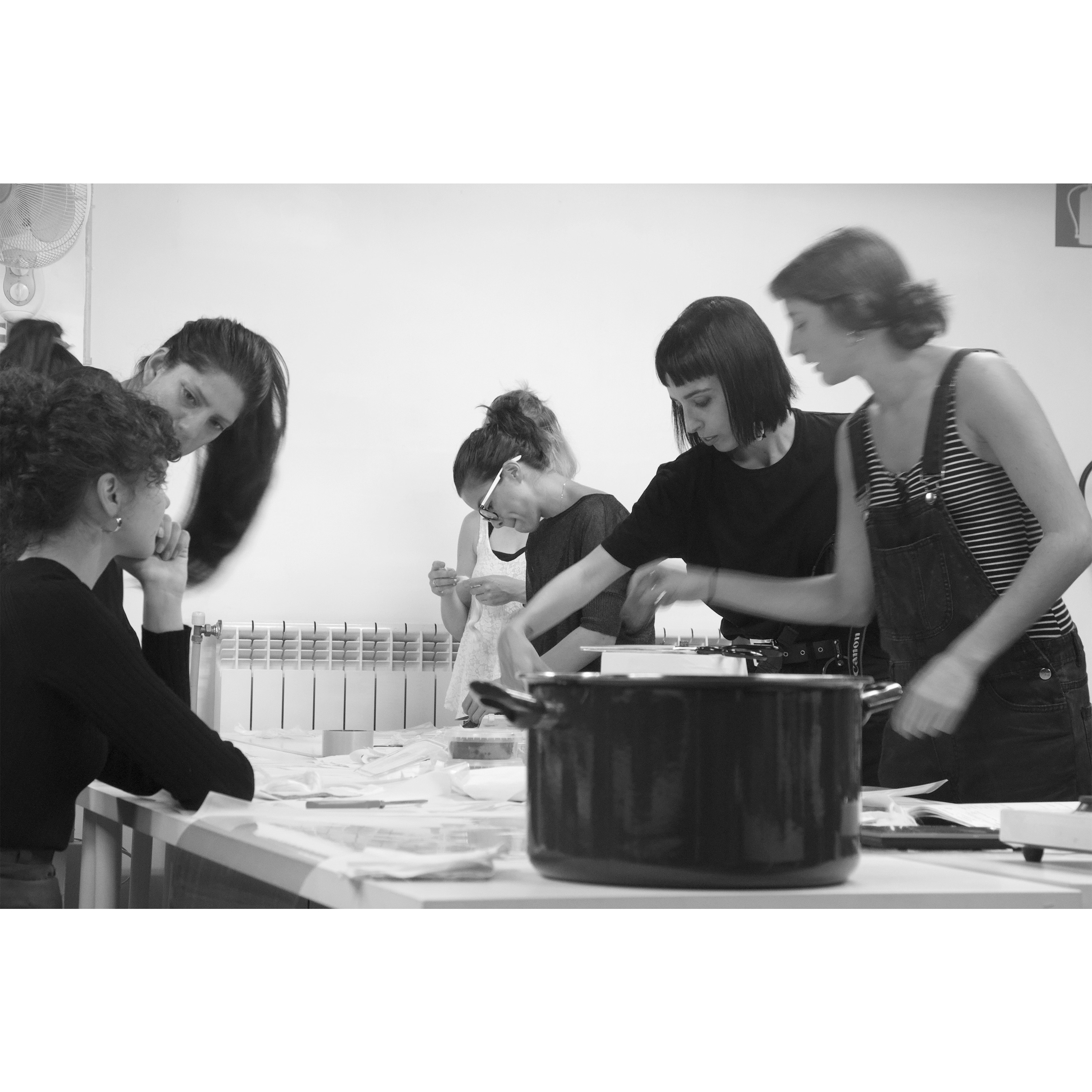4. BIOFABRICATING DYES AND MATERIALS#
“In trying to foresee the future it is easy to feel overwhelmed by the wonders of technology, but could the most avant-garde innovations be organic? Embrace nature instead of trying to dominate it.”

Bacteria Dyeing#
The bacteria we use is type B and its name is: Serratia / Coloration: Magenta - Pink We work within Laboratiorio, for this it is necessary to follow the steps methodically and have certain cares:
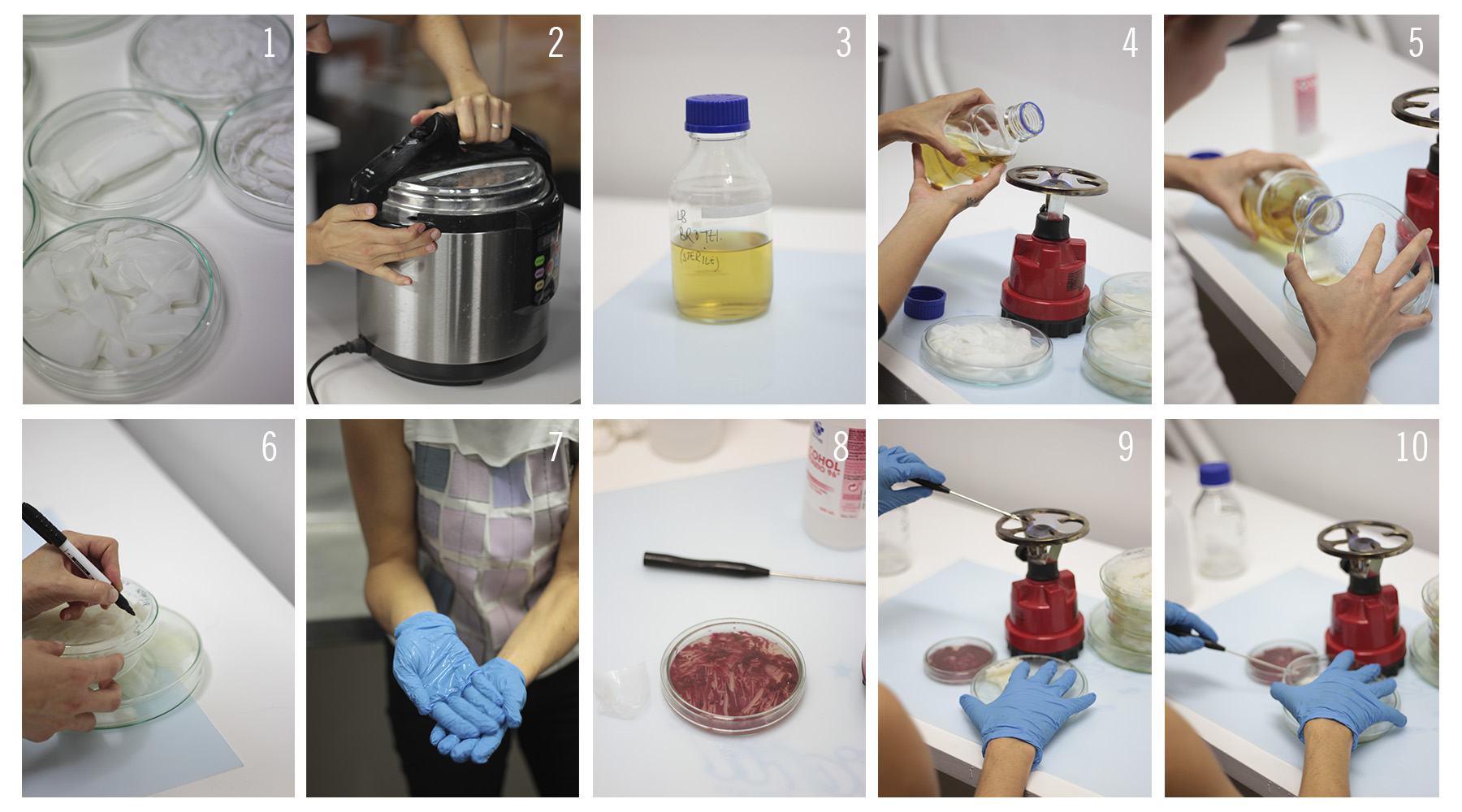
- 1 The textile used was silk, each student applied a technique (folds, knots, seams …) to generate different patterns in the final finishing of the cloth, which is exciting since it depends on the growth of the bacteria in it and it is discovered at the end of the process. They are each arranged inside Petri dishes.
- 2 Then, all the samples are placed in a special bag to be introduced inside the pressure cooker, to be sterilized (the process takes 15 minutes).
- 3 For the growth of said bacteria, it is necessary to give it food, for this purpose broth is used.
- 4 Once the sterilization is finished, the work space must be prepared; alcohol is poured in a circular way, the gloves are placed and in the center we have the carafe (fire) and the containers as close as possible.
- 5 Every time we pour the broth inside the Petri it is necessary to heat the mouth of the bottle’s peak on the fire beforehand. The process must be agile and fast, trying to keep the container as short as possible and open space.
- 6 With an indelible marker, each sample is labeled, with name and date
- 7 Hands and work space are cleaned again.
- 8 Extract the bacteria from the incubator.
- 9 To take portions of said bacteria, a metallic utensil is used, each time it is introduced inside the Petri it is necessary to heat it over the fire.
- 10 The bacterium is introduced on the textile and the container is closed quickly.
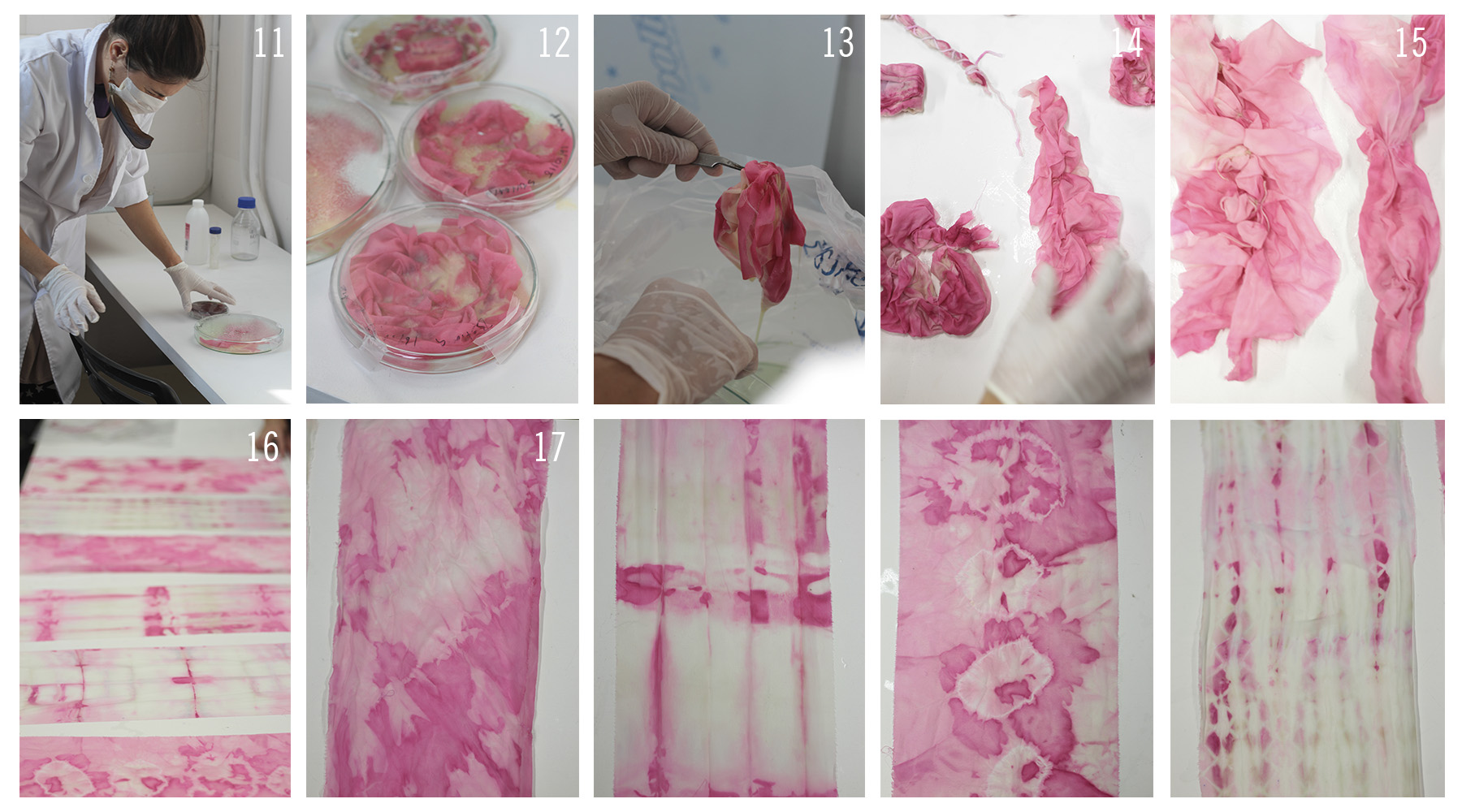
- 11 After 2 days of waiting, we returned to the laboratory and extracted the textiles from the incubator.
- 12 In each container, the bacteria was seen with different intensities and growth dimensions.
- 13 This is the part that is called: “kill the bacteria”, the textiles are extracted in one bag and the containers in another, to be then sterilized separately.
- 14 After the sterilization process, the threads are cut and the folds disarmed, to begin to discover the dyeing pattern!
- 15 The textiles are washed to eliminate the remains of broth.
- 16 Very different characteristics can be observed in each sample.
- 17 In my case, I had made small stitches with thread, “puckering” the textile, the bacteria grew in great coloration and dimension within it. The result were organic colored spots.
Natural Dyeing#
Every year with the process of dyeing with water the fabrics are poured the equivalent to 50% of the volume of the Mediterranean Sea in our rivers and streams. To this we add 200 thousand tons of toxic chemicals that escape the treatment of wastewater and end up in the same water courses. All this tremendous environmental impact only to dye fabrics.
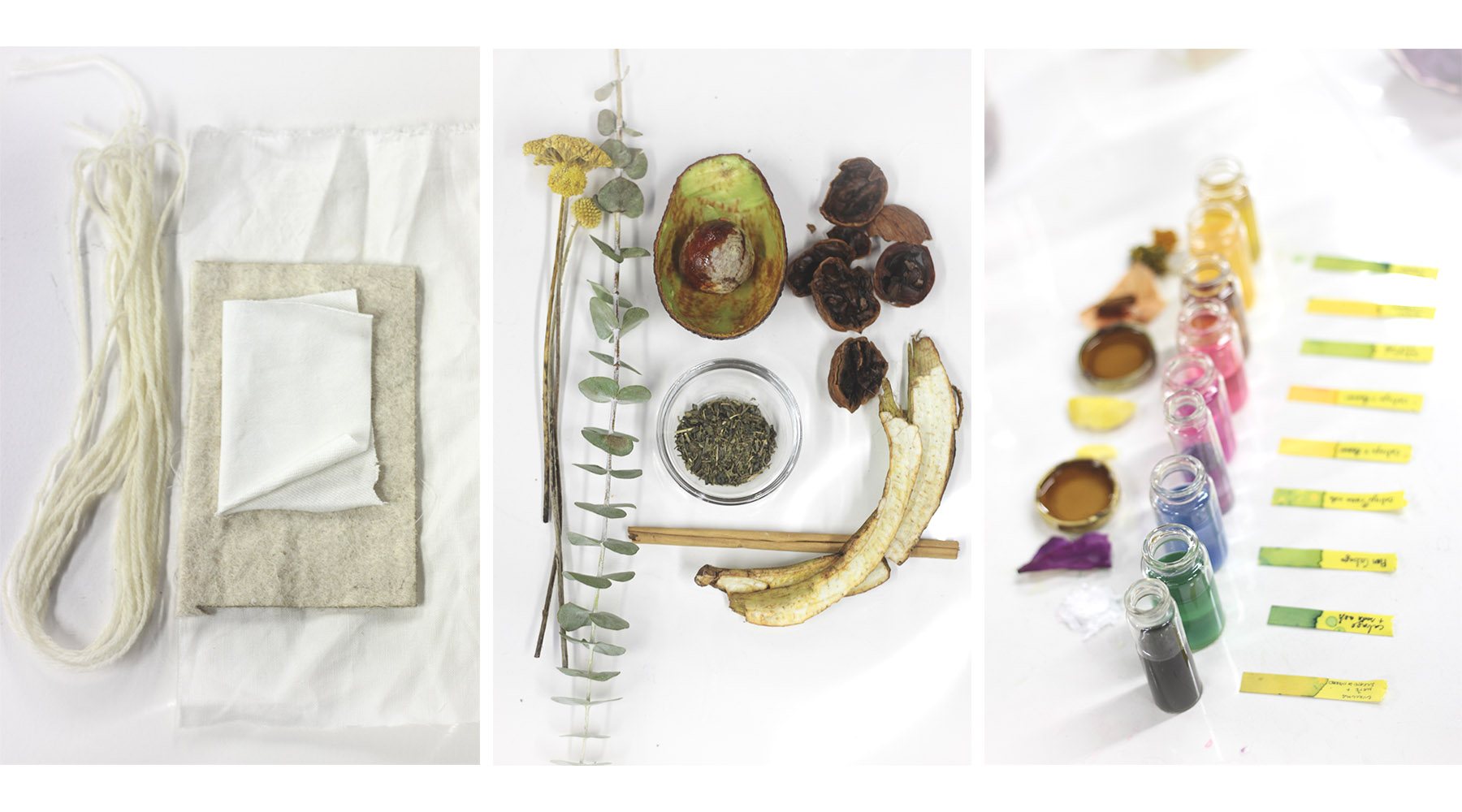
We experiment with various textiles, the process of dyeing with fruits and vegetables; obtaining a wide sample of natural dyes.
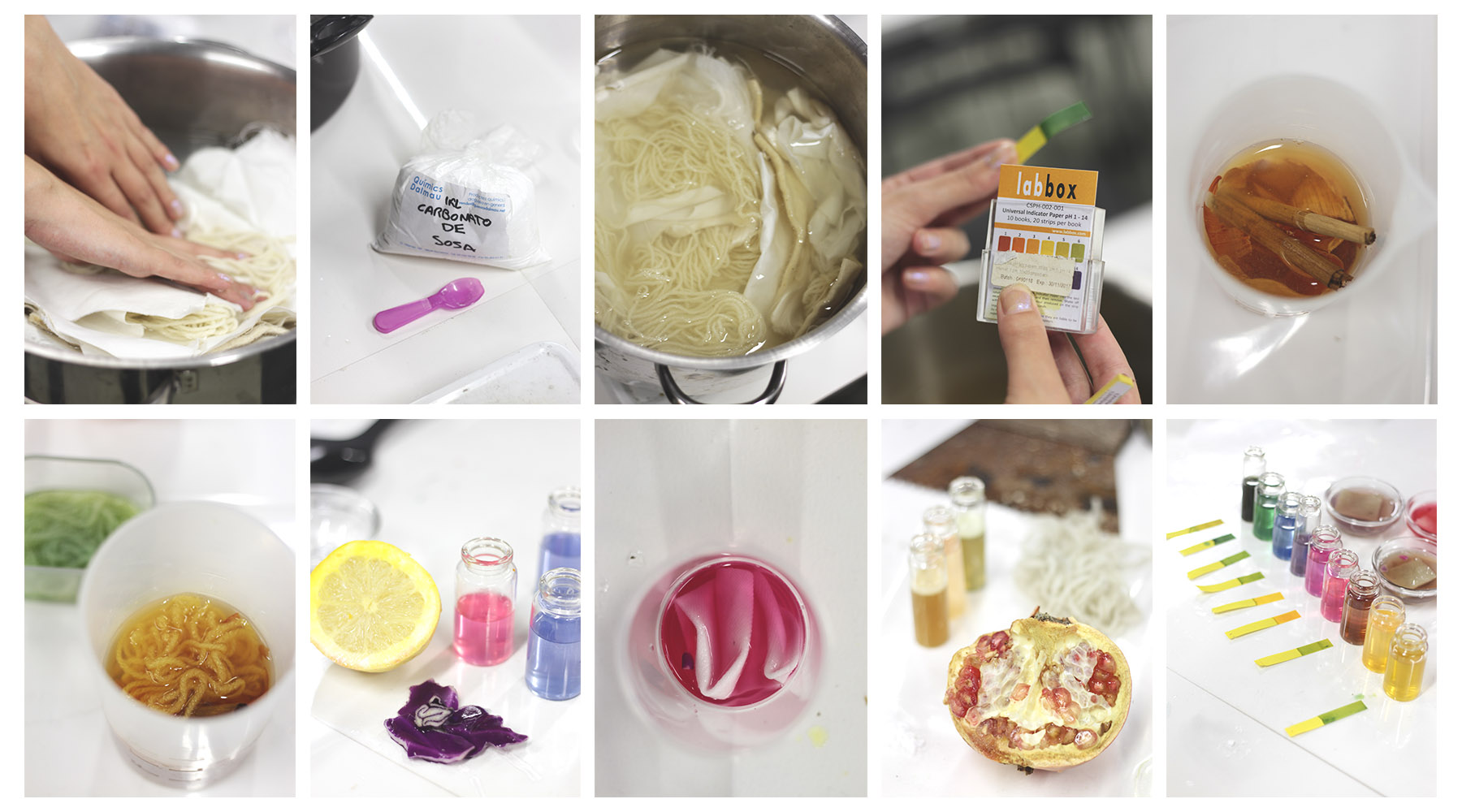
- Weight the fabric to dye.
- Clean de fibers adding Bicarbonato de SOSA (no soda) into warm water. 2spoon per 4lt.
- The alum mordant should be 15% of the fabric weight. In this case for 38.3gr of fabric we used 6gr of alum.
- Boil clean water that cover the fabric. Add the alum and mix it. Add the fabric.
- Lab Box, helps us to measure the pH of the liquid medium to be used.
- In my first sample, use onion peels and cinnamon. The hue of the dyeing resulted from a faint copper brown.
- Playing with the PH: we discover adding iron substrate the color intensifies, transforming for example brown copper to tobacco brown; likewise, it reacted with other components such as blue-violet dye cabbage. Another surprise was when we added lemon to the dyes, the colors changed instantly, for example from cabbage blue to pink. This way we could create in a group, a wide chromatic scale of natural dyes as a result of this fun afternoon.
- Observations: many samples of different shades were obtained, although in its majority very tenuous, in my opinion, it is because it lacked time to rest with the dye.
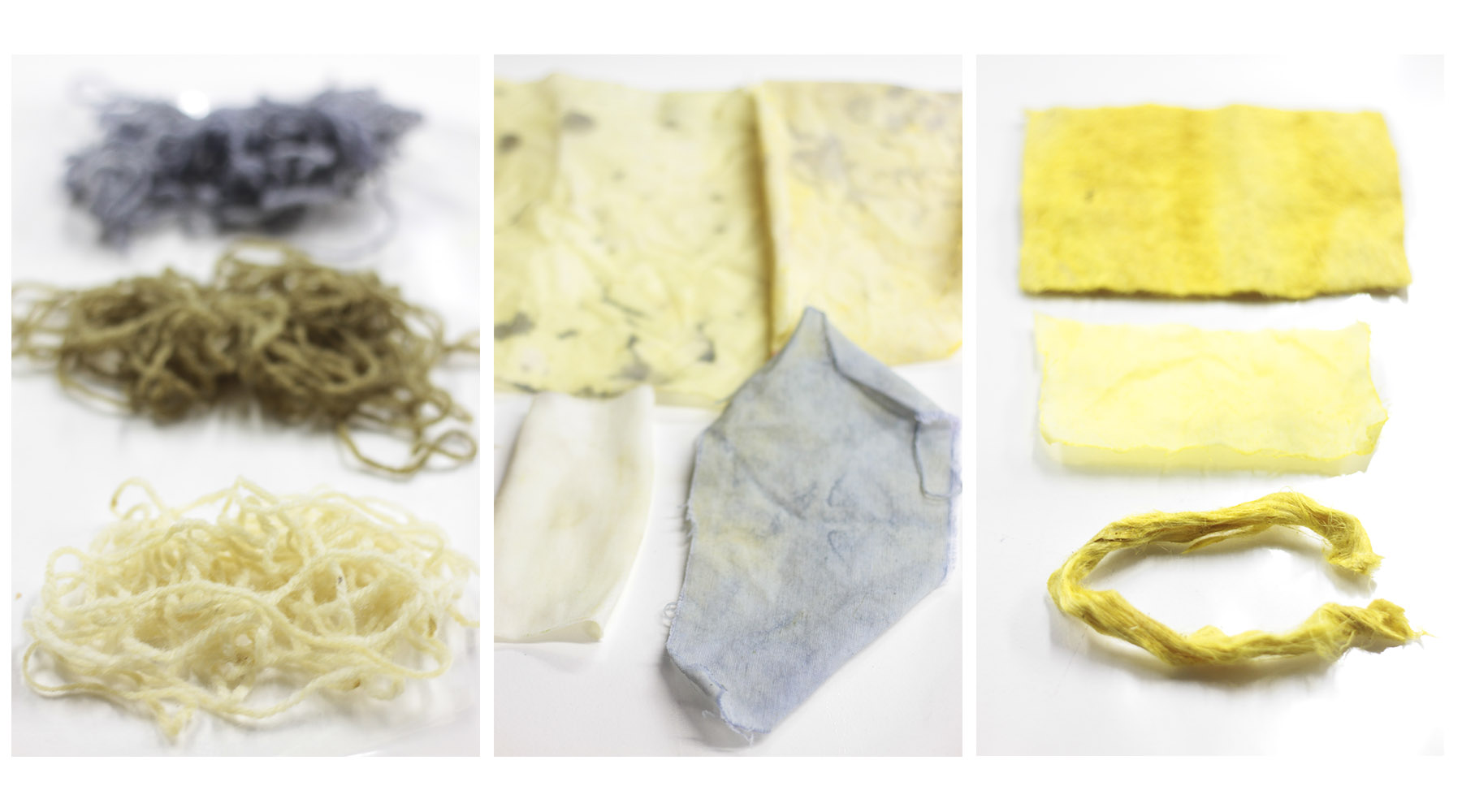
Kombucha Leather#
The kombucha (known as Manchurian mushroom, tea fungus or Chinese mushroom). These fungi and bacteria convert sugar (sucrose) into glucose and fructose and then into ethyl alcohol (potable), carbon dioxide (CO2) and acetic acid, all living in a symbiosis of mutual benefit, forming a body of liquid on the surface of the liquid. gelatinous appearance similar to a jellyfish. If the fungus receives food continuously, this process has no end, that is why the kombucha is called “the fungus of immortality.” Formula for the growth of Kombucha:
- 1lt. of water
- 100 gr. of sugar
- 100 ml. of vinegar
- 2 units of green tea
As a group, in the laboratory we began the growth of Kombucha, in different containers, to then analyze the potential and use this material. Fortunately, the Kombucha grew rapidly (during the period of approximately one month it was fed with fruit sugars) and we decided to remove it from its fertilization medium, wash it, dry it on a 45 ° surface preferably of wood to absorb moisture and use it as Organic leather in some of our personal projects.
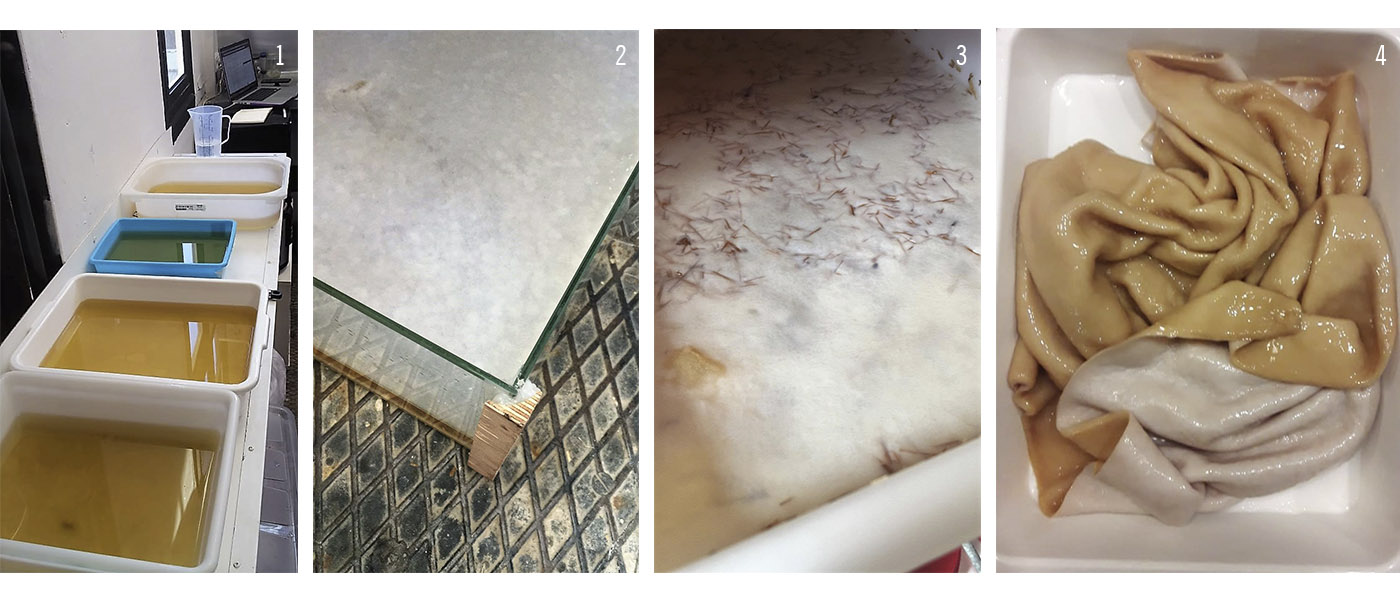
BIO-Plastics#
In particular, this material and first group experimentation aroused much interest in me; We are surrounded by plastic products, which we will never see degrade. Fruit based bio-plastics amazed me, seeing images of what could be achieved as a final “organic leather”, I decided to go this way. Another motivation was to take advantage of the “waste” of the fruit skin:
Of all the fruits we produce for consumption, 45% is discarded. 30% of the agricultural land on Earth is used to produce food that will eventually be thrown away. This is often due to the fact that the consumer has bought a lot or because retailers refuse food because of their appearance. 10% of all greenhouse gases in rich countries are emitted by producing food that will never be eaten. In addition to the problem of food waste, the production of animal hide is also an environmental problem. The impact is greatest among the poorest and least developed regions of the world. Each year, more than one billion animals are slaughtered so that the skins can be used. The cleaning process suffered by the skins produces around 650 million kilos of CO2 around the world.
Process and Recipes#

- 1 I used the skin of 2 Mangoes, 2 Bananas and 2 Citrus fruits separately; I previously soaked them in boiling water and let them rest in it for one night.
- 2 I processed the skins and drained the surplus water. Obtaining 3gr of mango skin and 5gr of processed banana skin. I divided these contents to try different recipes.
- 3 Recipes:
- Bio material based on GELATINE: Gelatin 48gr. / Glycerin 12gr. / Water 240ml.
- Bio material based MAIZENA: Maizena 30gr. / Glycerin 5ml. / Vinegar 5ml. / Water 50ml.
- Bio material based AGAR AGAR: Agar agar 2gr. / Glycerin 12gr. / Yeast 30gr. (add this component to see if it generated a different reaction) / Water 250ml.
- 4 In all cases the procedure is the same, dissolve the binder in the water (make sure there are no lumps) add the rest of the components and bring to the boiling point.
- 5 Incorporated the resulting mixture to the processed fruit skin and mix it with the processor.
- 6 I poured the final mixture into different containers and surfaces; plastics, leather trim (putting glycerin as non-stick) and on cloth to see if it turned out to be an air filter on both surfaces of the material. (images of the bio-materials unmoulded with 2 days of drying).
Classification and comparison table#
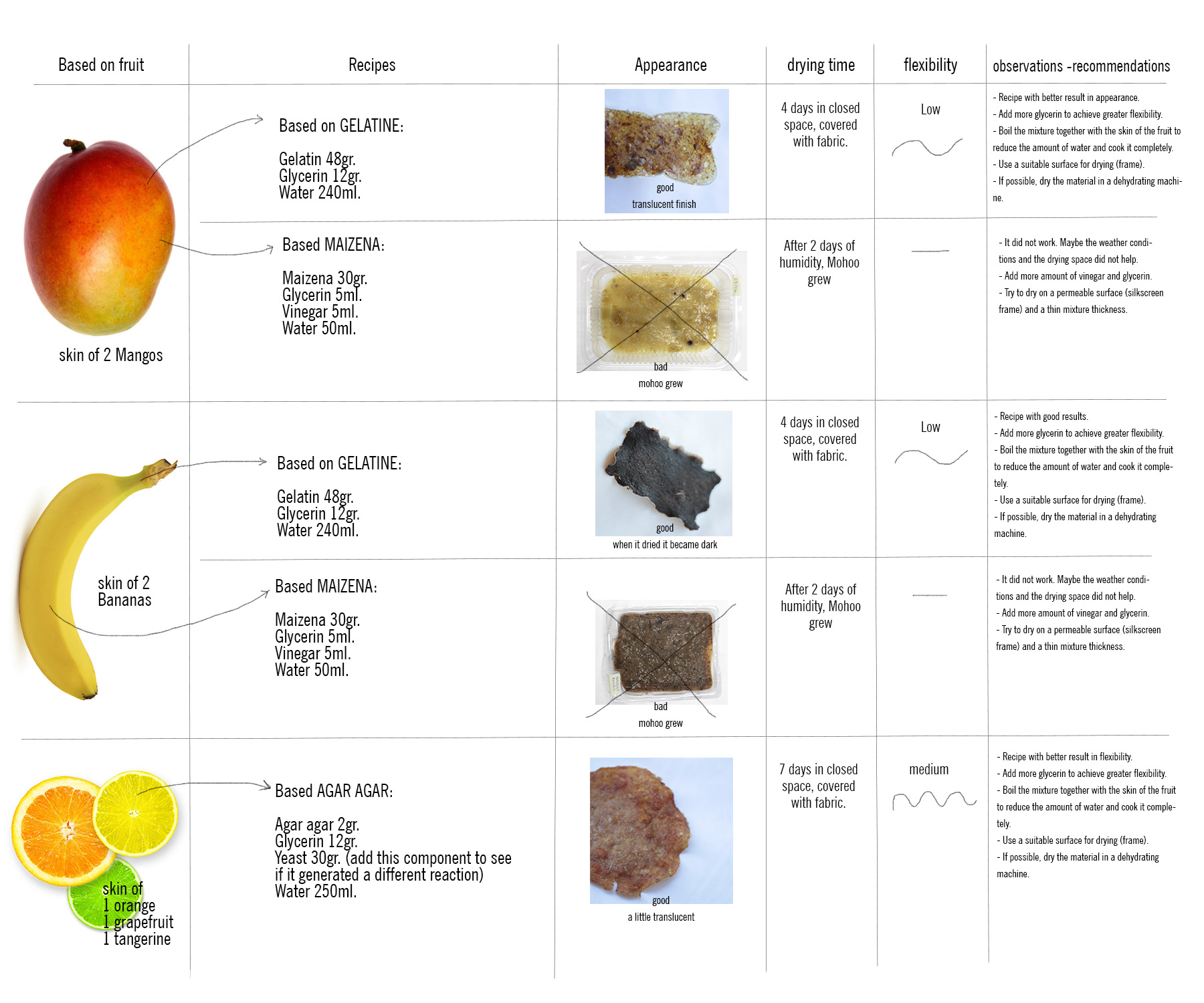
Observations and conclusions:#
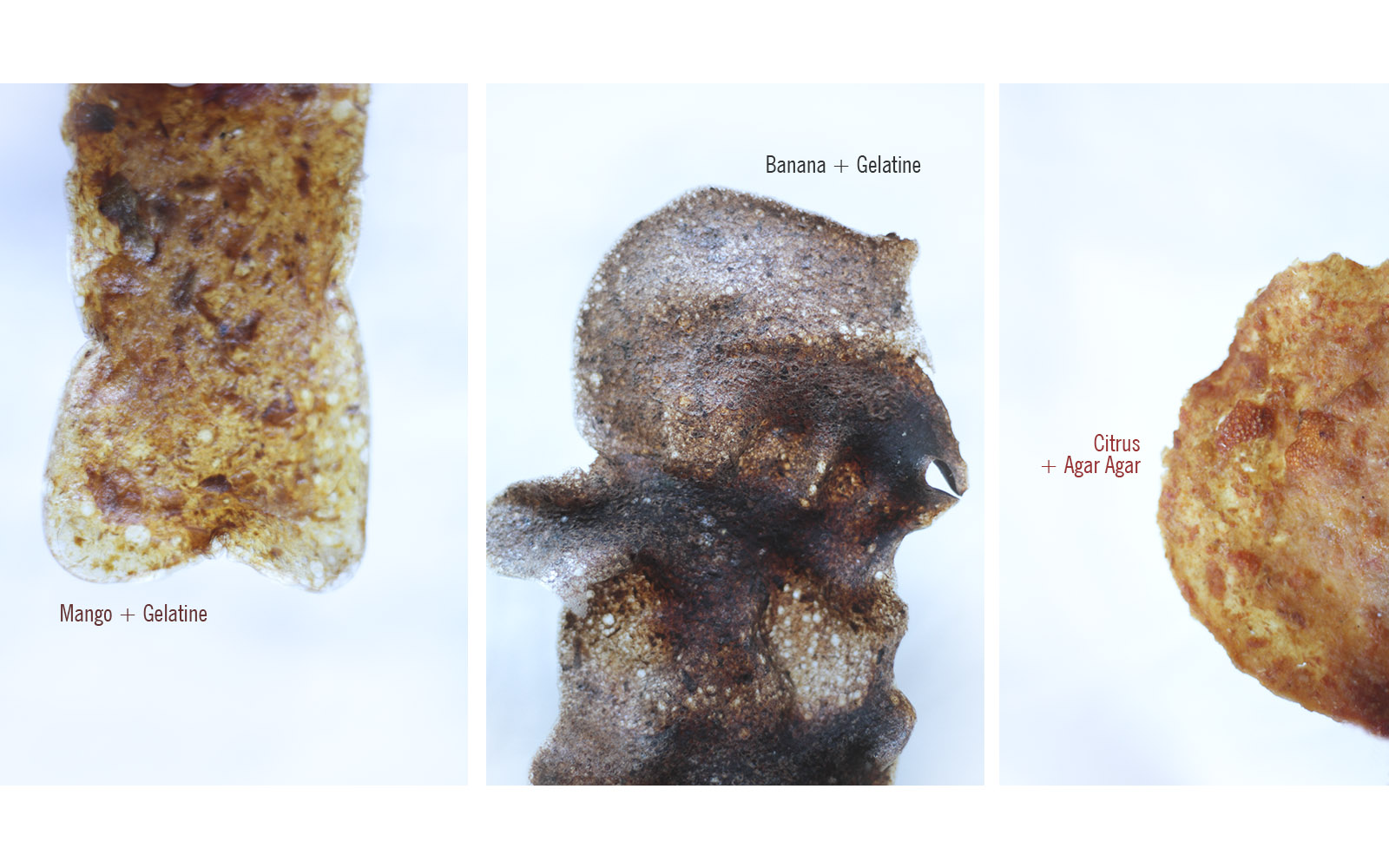
After waiting a few days to reach the drying of the Bio-materials, I have come to the personal conclusion that the most appropriate recipe is Gelatin; since it had a faster drying and translucent finish that allows to see the fruit fibers. The corn-based recipe did not work for me, during the days of waiting for its drying, mushrooms appeared (mohoo) and I had to discard them. The recipe of Agar Agar still remains with some humidity (5 days later) but in favor, the material has more flexibility. - The points to check to get to the material that I intend to result in “fruit leather” textile use is to add more glycerin to achieve greater flexibility and use a suitable surface for drying: rack (I read that those used for screen printing give very good result , since they allow air flow on both surfaces but the screen of the mesh is sufficiently closed and non-stick so that the freshly cooked bio material does not leak). - To avoid the formation of mohoo in the material, it should have boiled the mixture together with the fruit skin to reduce the amount of water and cook it completely. This step I could not carry out in this first stage of experimentation since in the laboratory we had elements of group use and the neutral mixture of binder was distributed among several students, so that each one would mix it with their chosen ingredients (in my case the fruit skins). Also, I still want to continue experimenting and refining my recipe, to reach the expected result and thus include this type of material in my final project, this is only the Bio-start!
